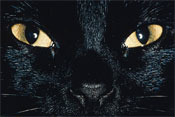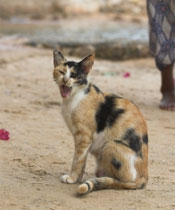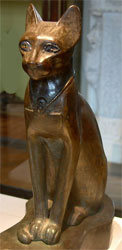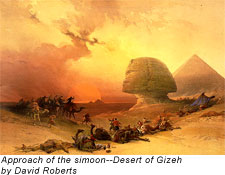|
 Old Friends: Cats and humans have lived alongside each other since the Stone Age. Their domestication reaches back at least 5,000 years, maybe more. A grave in Cyprus was discovered in 2004 estimated to be about 9,500 years old, containing the remains of a cat beside a man, suggesting a much older relationship. Old Friends: Cats and humans have lived alongside each other since the Stone Age. Their domestication reaches back at least 5,000 years, maybe more. A grave in Cyprus was discovered in 2004 estimated to be about 9,500 years old, containing the remains of a cat beside a man, suggesting a much older relationship.
 The first housecats were most likely descended from African Wild Cats. Obviously, having Wild Cats around the house, can be a very risky relationship, for both species, but it had some clear benefits. For the cats, they discovered that human civilization offered them an easy source of food, especially around storehouses and trash dumps. Littered with mice and rats these places made for easy pickings for the skilled hunters. And the humans found a very inexpensive and efficient means to control rodent populations because although cats killed off mice and other rodents they tended not to touch the grains, fruits, or vegetables. A mutualistic relationship developed; that is, each species derived a clear benefit from the relationship. Some claim the Egyptians began to leave food out for the cats, bringing them closer and closer to their homes. The cats, seeing the humans as generous, became less aggressive. The first housecats were most likely descended from African Wild Cats. Obviously, having Wild Cats around the house, can be a very risky relationship, for both species, but it had some clear benefits. For the cats, they discovered that human civilization offered them an easy source of food, especially around storehouses and trash dumps. Littered with mice and rats these places made for easy pickings for the skilled hunters. And the humans found a very inexpensive and efficient means to control rodent populations because although cats killed off mice and other rodents they tended not to touch the grains, fruits, or vegetables. A mutualistic relationship developed; that is, each species derived a clear benefit from the relationship. Some claim the Egyptians began to leave food out for the cats, bringing them closer and closer to their homes. The cats, seeing the humans as generous, became less aggressive.
Cat Goddess: In Egypt, the relationship became something more than master and servant. Living along the Nile made the Egyptian storehouses particularly susceptible to rats and mice, making cats that much more essential. This dependency soon became outright worship. Slowly, religious cults arose around cats.
 Eye of Ra: By 1500 BC (at the latest), cats became closely associated with Bastet, a solar deity, and protectress of the Pharaoh. Known as the “eye of Ra”, she originally had the body of a woman and head of a lion and was considered the instrument of the sun god’s vengeance. But over the centuries she became more domesticated and soon the lion’s head was replaced with a domesticate cat’s. The change from a more aggressive deity to one of a more tender nature developed naturally when people considered the domesticate cat's nature. Cats are devoted and gentle mothers, and soon Bastet became associated with motherhood and fertility. Expectant mothers prayed to her for protection, and barren women prayed for help. Sometimes however, even centuries later, Bastet was represented holding a a lion’s head at her side, suggesting the ferocity that lay buried in her subconscious, similar to a domesticate cat’s. She was beloved all the same, and soon the most pleasant and joyful aspects of Egyptian life were placed under her protection. The sunrise, music, dance, and pleasure as well as family, fertility, and birth all fell under her domain. Eye of Ra: By 1500 BC (at the latest), cats became closely associated with Bastet, a solar deity, and protectress of the Pharaoh. Known as the “eye of Ra”, she originally had the body of a woman and head of a lion and was considered the instrument of the sun god’s vengeance. But over the centuries she became more domesticated and soon the lion’s head was replaced with a domesticate cat’s. The change from a more aggressive deity to one of a more tender nature developed naturally when people considered the domesticate cat's nature. Cats are devoted and gentle mothers, and soon Bastet became associated with motherhood and fertility. Expectant mothers prayed to her for protection, and barren women prayed for help. Sometimes however, even centuries later, Bastet was represented holding a a lion’s head at her side, suggesting the ferocity that lay buried in her subconscious, similar to a domesticate cat’s. She was beloved all the same, and soon the most pleasant and joyful aspects of Egyptian life were placed under her protection. The sunrise, music, dance, and pleasure as well as family, fertility, and birth all fell under her domain.
 Cat Party: The Greek historian Herodotus wrote of great festivals and magnificent temples in Bastet's honor. Her temples were often occupied by hundreds of cats. These cats were sometimes mummified and given great tombs; fully supplied with mice, rodents, milk and saucers of food. The most spectacular of these was found in Bubastis, where the remains of some 300,000 cats were found. Cat Party: The Greek historian Herodotus wrote of great festivals and magnificent temples in Bastet's honor. Her temples were often occupied by hundreds of cats. These cats were sometimes mummified and given great tombs; fully supplied with mice, rodents, milk and saucers of food. The most spectacular of these was found in Bubastis, where the remains of some 300,000 cats were found.
In many a household the cats ate the finest foods and were denied nothing, with rights even to the master’s plate. A cat’s death was subject to public mourning and a priest inspected the corpse to see if its death had occurred naturally or not. Their human families sometimes mourned for weeks, even shaving their eyebrows to show their sorrow.
 Cat Crimes: It was crime for anyone to kill a cat. Cats may have even been seen as more important then people or cities. Herodotus tells of men lining up in front of a blazing fire to stop any cat from getting to close. And there was at least one instance where an Egyptian general surrendered an entire town to save cats. The Persians had been besieging the Egyptian city of Pelusium, but to no avail, since the Egyptians held fast. Frustrated, the Persian general searched for a solution. Recognizing the Egyptian devotion to
cats, he decided to sent his men to capture as many cats as they could, then released them onto the battlefield. When the Egyptians saw the battlefield crowded with cats, the general surrendered the entire city rather than harm the cats. Cat Crimes: It was crime for anyone to kill a cat. Cats may have even been seen as more important then people or cities. Herodotus tells of men lining up in front of a blazing fire to stop any cat from getting to close. And there was at least one instance where an Egyptian general surrendered an entire town to save cats. The Persians had been besieging the Egyptian city of Pelusium, but to no avail, since the Egyptians held fast. Frustrated, the Persian general searched for a solution. Recognizing the Egyptian devotion to
cats, he decided to sent his men to capture as many cats as they could, then released them onto the battlefield. When the Egyptians saw the battlefield crowded with cats, the general surrendered the entire city rather than harm the cats.
Fall from Grace: The reign of the cat declined however, and soon their place in society changed. By about 300 BC there is evidence that many cats were raised with the intention of being sacrificed. Deep scans of mummified cats discovered that many cats had broken necks before mummification, suggesting the animal was intentionally killed.
At this time, the entire Egyptian Kingdom was in decline. But the cats had already found their way to the rest of the world. Traders often took the cats onto ships to protect their food storage from vermin. When the boats docked in a foreign city, the cats escaped and began a new life.
|
